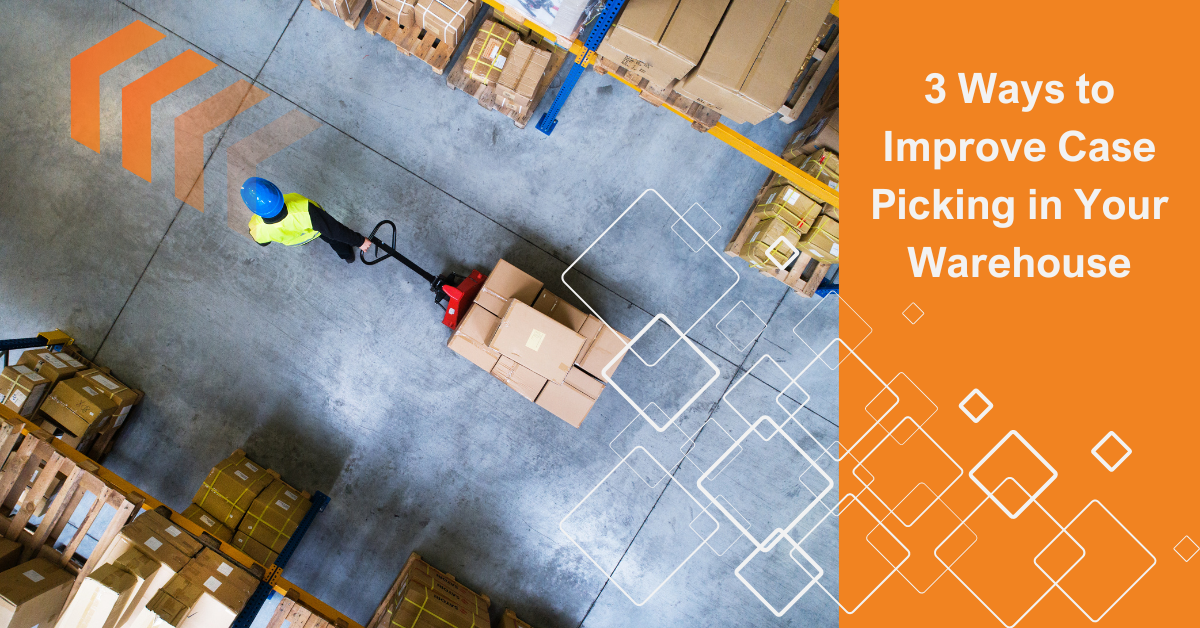


Picking is one of the most labor-intensive processes in the warehouse. Some estimates state that order picking alone can add up to 55% of operational overhead for a warehouse, so it stands to reason that warehouse operators need to do everything they can to optimize picking processes. There are many types of picking, but one that often gets left out of the improvement conversation is case picking. Why is that?
In case you didn’t know, case picking refers to taking entire cases or cartons off of warehouse shelves and placing them on pallets to be shipped to customers. Contrast this with, say, picking single items one at a time to fulfill an order. There are a variety of tools and tech that people have developed to make case picking more efficient but, in many warehouses, it’s still primarily a manual process.
Which leads us to the labor problem. According to a 2023 survey, 34% of warehouses lost business because they couldn’t find enough people. It’s an issue that’s affected almost every part of the industry for the last several years, and it doesn’t seem to be going anywhere soon. Since case picking requires pallets, forklifts are frequently involved, and forklift operators are even harder to find than floor workers due to the certifications they need.
Whether the labor market self-corrects or not, it’s still a good idea to make case picking as smooth and efficient as you can. Here are three ways to make your case-picking processes faster, more effective and safer.
One way to improve case-picking operations is to break your warehouse floor into zones. Then, you assign workers to each zone. Instead of having your workers carry pallet jacks across your entire warehouse or walk alongside a forklift for miles, they only pick cases in their respective zones, cutting down the amount of walking they have to do. Less walking means your workers are less likely to get exhausted, which lowers the chances of them getting injured on the job. It also makes their jobs easier, which makes for a better work environment and lower attrition.
Additionally, zone picking makes your workers more productive. Since they only have to pick from a limited area, they don’t have to spend as much time searching for items that they might not know the locations of. And zones are modular, which means you can change their size and the number of workers assigned to each one based on demand, which keeps your operation flexible.
In a similar vein, you can speed up picking times by optimizing the routes your workers take to get from point to point or by augmenting their picking with technology. If you really want results, you can do both.
To streamline routes, you need warehouse management software of some kind. If you use a multiagent orchestration platform, you can use one system to manage your hardware and your people so that all your picking agents follow the optimal route for every order.
Technology-wise, the best options are solutions that make it easier for your pickers to find the cases that they need to pick and ensure that they get loaded onto the proper pallets. This can be done with screens or via advanced systems that give pickers verbal instructions on what to grab next. Both methods usually involve barcode scanners, which can be wrist-mounted or even worn on the head to make sure that pickers select the correct items. This also typically updates the inventory management system, which helps the warehouse keep tabs on what’s in stock.
RELATED READ: How to Pick Faster in a Warehouse
Robots are another great way to improve case picking, especially when combined with the other two strategies highlighted above. Intralogistics (IL) robots are specialized to play the role usually taken by pallet jacks or forklifts during case picking, reducing labor needs and further streamlining the process. In this use case, the IL bots play the role of cobots, meaning they assist human workers with their tasks.
Tying the bots directly to a fulfillment orchestration platform allows you to optimize their routes through your warehouse with AI. This way, they move around in the most efficient manner possible without any human input. This also cuts down dramatically on walk times, especially when paired with zone picking.
Furthermore, using orchestration software with cobots enables palletization, a system-informed process where the orchestration software shows workers exactly where a case should be placed on the pallet they’re working on. Altogether, the process looks something like this: the platform guides workers to their next pick via a handheld device and dispatches IL cobots to meet them there. Then, it shows the worker where to put the case on the pallet, ensuring that each pallet is being used as effectively as possible.
An example of a palletization interface
It’s worth nothing that IL robots are safer than the forklifts they’re often compared to – in 2022, forklifts were the cause of 24,960 workplace injuries and 73 deaths in the U.S. Not to mention they’re equally as capable of causing damage to inventory and equipment. Robots follow set routes, they don’t get tired at the wheel and they’re equipped with SLAM or similar navigational systems to prevent accidents.
To get the highest possible efficiency, it’s best to combine the strategies outlined here. Workers who are responsible for only their zones are more efficient, optimizing their routes and guiding their actions makes them more effective, and Autonomous Mobile Robots (AMRs) cut down on labor needs while improving safety and reliability.